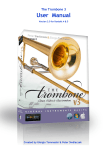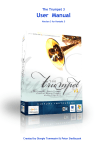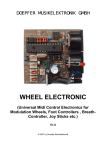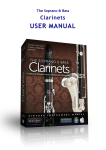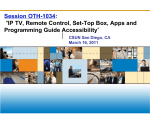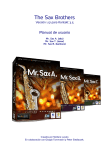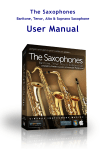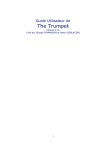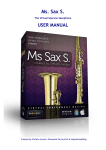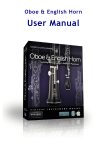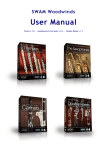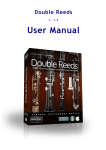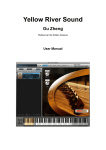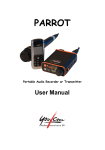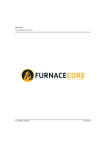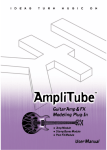Download French Horn & Tuba - Manual
Transcript
French Horn & Tuba User Manual v. 1.03 Table of Contents Before you start 3 Kontakt 4 Installation Online Activation Support MIDI note starndard System requirements CPU load MOST IMPORTANT 3 3 3 3 4 4 5 Introduction 6 The Instruments 7 The Mutes 7 The Graphical Interface (GUI) 8 Velocity Curve Remapping Controller Knobs The Controllers and their function Volume control by CC7 The Mutes CC remapping Wind Controller Mode Breath Controller Mode Portamento Time Transpose Microtuning 9 10 11 13 13 14 14 15 16 17 17 Playing Techniques 19 French Horn "ensemble" 22 The Performance Keyswitches 23 Technical Support 25 Updates 25 2 Before you start Before installing “French Horn & Tuba”, please read carefully the items below: Kontakt 4 Player The French Horn & Tuba is supplied with the NI Kontakt Player 4.2, the read-only version of Native Instruments flagship sampler. It involves many new features and bug fixes, including 64 bit, extended memory and multicore support, DFD optimisation, better compliance with some OS and hosts, aftertouch support etc. The Player is included as a separate installer, and no additional software is required to play the instrument. Stand-alone mode, as well as plugin formats VST, DXi, RTAS and AU are supported. For further details, please refer to the Kontakt Player Manual. Kontakt 4 Sampler The instruments can be also loaded and played in the full version of Kontakt 4.2. Please note, however, that they cannot be opened or modified, and no access to the samples, impulse responses or instrument programming is provided. Kontakt 5 Users of Kontakt 5 (either the Player or the full Sampler) can safely load and play French Horn & Tuba. Installation Please read carefully and follow the instructions found in the separate Installation Guide. Note: If the full Kontakt 4.2 Sampler, or the Kontakt 4.2 Player is already installed on your system, no Player installation is needed. Earlier Kontakt versions cannot be used. Note:In case your computer has no internet connection and the offline activation is required, or in case you need any assistance while installing, activating or using the instruments, please contact the Native Instruments support: http://www.native-instruments.com/support.info Note: All the MIDI note names we use refer to C3 as the middle C. This means: C3 is the MIDI note number 60. 3 System requirements Operating systems PC: Windows 7, Vista or XP, 32 or 64 bit Mac: Intel only, Mac OS 10.5, 10.6 or 10.7 Computer The French Horn & Tuba, like the other Samplemodeling instruments (The Trumpet, the Trombone and the Sax family) provides unprecedented realism and expressiveness. However, it’s a demanding software in terms of CPU load. A modern PC or Mac with at least 1,6 GHz Core2Duo CPU is required. Less powerful systems may also prove satisfactory, but may require larger buffer sizes, involving higher latencies, and may even reduce the amount of simultaneously playable instruments down to 1. Note: This may not represent a real problem though. Using the freeze feature or bouncing the single MIDI tracks to audio is a useful remedy. Important note on CPU load Loading multiple instruments on a single instance of Kontakt leads to a less efficient use of the multiple cores, and to an increased CPU load. In case you are experiencing excessive CPU load and/or dropouts, we strongly recommended to use a separate instance of Kontakt for each instrument. Audio Interface (sound card) A good quality audio hardware with suitable low latency drivers (ASIO for the PC) is required. Buffer size should be kept to 256 (recommended) or 512 samples (higher latency, but less CPU load). Midi interface A MIDI interface is required if using a MIDI keyboard, another MIDI controller or an external sequencer, unless the connection is made via USB. Keyboard or Windcontroller A five-octave midi keyboard, mappable from C-2 to C5, with pitchwheel, modwheel, and an expression pedal or breath controller, constitutes the minimum requirements for real time playing. Six-octave keyboards with several physical MIDI controllers, including expression and sustain pedals, or a Windcontroller, are recommended for full exploitation of the expressiveness of the instrument. Sequencer. If real time playing is not contemplated (you will miss a great fun though), using a sequencer may obviate the need for several physical MIDI controllers, while maintaining full control of the instrument expressiveness. “The French Horn & Tuba” has been thoroughly tested on several sequencers, including Cubase, Ableton Live, Digital Performer, Logic and Sonar. 4 Supported Plugin Formats PC: VST or RTAS, 32 or 64 bit Mac: AU or VST, 32 or 64 bit (For more details please refer to Kontakt 4.2 or 5 Specifications on the Native Instruments site) MOST IMPORTANT: Like a real instrument, and differently from conventional sample libraries, French Horn& Tuba allows continuous transition across the dynamics (from ppp to fff), free from any side effects. To accomplish this, a suitable continuous physical MIDI controller, such as an expression (CC11) or volume (CC7) pedal, a breath or a windcontroller (CC2) is absolutely necessary. WITHOUT THIS CONTROLLER THE INSTRUMENT WILL NOT WORK, displaying a warning. Other physical MIDI controllers, like sliders, knobs or modwheel, though not recommended, can be used for this purpose. Please refer to the Remapping section of this manual for further details. Tip:Logic users, deactivating French Horn& Tuba track my reduce the CPU load, and greatly improve the overall performance. Tip:Sonar users might experience hanging notes upon stopping the playback.This is due to the fact that Sonar sends an “All-Notes-Off” command when the Stop button is pressed.The problem can be easily solved by checking the box “Accept all notes off/ all sounds off”under “Instrument Options -> Controller”, as shown below. 5 Introduction The French Horn is an exceptionally versatile, dynamic, flexible and expressive musical instruments, used in a vast majority of musical styles. It covers an incredibly wide dynamic range. With its rich, warm sound it is a perfect blender, if used in combination with other instruments. With its full, bright fortissimo it is an indispensable instrument in any spectacular, “Hollywood-like” orchestration. The real French Horn is extremely difficult to play, requiring advanced skills and intensive practicing. It is also extremely difficult to emulate, a true challenge for developers of virtual instruments. That's why we chose it next. We believe the results are outstanding. And, unlike the real one, our virtual French Horn is very easy to play… Tuba – the biggest brass instrument – covers the lowest range of the musical scale and is really not limited to comedic work at all… It contributes remarkably to the fullness of the orchestral sound frequently doubling the bass lines, but also serves as the bass in the brass section or brass band, as well as a solo instrument, playing all possible musical styles. Like the other Kontakt-based Samplemodeling instruments, French Horn & Tuba use Giorgio Tommasini's proprietary "Harmonic Alignment" technology. It enables realtime, seamless morphing over the entire dynamic range, from pp to ff, an impossible task for conventional sample-based libraries. Furthermore, it uses recorded samples of real instruments as base material. This proved to be the best choice to preserve the timbral characteristics of the original instrument. We used stateof-the-art recording techniques, including multi-microphone placement, according to the radiation characteristics of the instrument. All sounds were recorded in an anechoic chamber. Why anechoic? The purpose of anechoic recording was threefold: 1) avoid “contamination” of the pure French Horn or Tuba sounds with the uncontrolled resonances of a particular ambience, 2) allow artefact-free “harmonic alignment” processing, 3) provide clean articulations and phrases as a database to build the “adaptive model”(see below). Early Reflections To recover the full, rich timbre of the instrument, including its radiation pattern, we developed specific “early reflections” impulse responses, adding virtual space to the anechoic sound. The intensity of this effect can vary from zero (pure anechoic sound) to slightly “roomy”, and is completely under user’s control. What we finally obtained is a pure, lively, homogeneous timbre without coloration, far from the “dead” sound that some might expect. 6 The Instruments The French Horn & Tuba package includes several instruments: - Solo Horn (“French Horn”); recommended for any application as a solo instrument. It has a well-balanced timbre and a neutral early reflection pattern. - French Horns 2, 3 and 4, which not only sound slightly different, but use also a slightly different response to the incoming controllers. These instruments are recommended for ensembles using separate MIDI tracks. - Four additional French Horns, labelled "for Unison Ensemble", specially devised for obtaining a realistic unison ensemble effect even when driven from one MIDI track. - A ready-to-use "Unison Horns" Multi, including these four specially devised instruments, properly levelled and panned, plus a suitable ambience / convolution reverb. This setup exploits a specially devised “ensemble maker” algorithm, allowing realistic unison playing even when using the same MIDI source for all the instruments. - All the Horns cover the range A0 – G4. - a Tuba, covering the range of the whole tuba family from Contrabass Tuba to F Tuba, i.e. from C0 to F3 All these instruments are now at your fingertips… You can really PLAY them – shaping the sound like a real player does. But please, read the manual first and learn more about how to do it in the best way. It is easy and intuitive but, like every music instrument, “French Horn & Tuba” needs some practice and experience. You will certainly learn it very quickly! The demonstrations we prepared show how realistic our instruments are. If you want to learn more about how this has been achieved, please visit the French Horn & Tuba Demo page and download the demos we prepared for you as MIDI files. The Mutes Mutes are devices affecting the timbre and/or volume of an instrument. Brass Mutes are mostly cone-shaped and are inserted into the bell. Depending on the shape or material (metal, wood, plastic) they may significantly vary the sound. The most common mutes used for the French Horns are: Straight, or Wooden Straight Mute, which is a cone-shaped, hollow mute providing more metallic and „nasal“ sound. It is available for all the brass instruments. Stop Mute, or Brass Stop Mute is unique for the French Horn. It’s a small brass bell inserted into the instrument bell, completely cutting-off the air flow. The result is a “buzzy” sound, which can be also achieved by the horn player tightly inserting his/her hand deep into the instrument bell. For special purposes, some additional effects can be loaded from within the French Horn Mute menu: “Bell Res. 1-3”. This option emulates the typical metallic resonances of the horn and is most effective in the higher dynamic range. Tuba can be played with a huge Straight Mute. Muting the Tuba, however, is not very common. 7 Our virtual instruments use sophisticated technologies to capture the “fingerprints” of each mute, which were ultimately coded into a suitable impulse response. The latter can be instantly loaded from a drop down menu of the graphical interface, or via MIDI, using CC100 (see MIDIloadable mutes, page 14). The Graphical Interface This is how the instrument looks upon loading. A warning message appears, reminding you that: An Expression controller (CC11, CC7 or CC2) is absolutely necessary for proper functioning of the instrument. Upon receiving the appropriate CC (from your keyboard or other midi sources, such as a windcontroller or sequencer), the warning disappears, and the instrument is fully functional. The grey button in the lower right corner opens a drop down menu. You may choose among several options: 8 Velocity Curve Mapping It is well known that midi keyboards have different and uneven velocity response, and this may heavily influence the performance of a virtual instrument. To obviate this problem, the instrument includes automatic detection of any velocity inhomogeneities or non-linearity emitted by the keyboard, and provides automatic remapping to any desired curve. If “Vel. curve” is selected in the drop down menu, the velocity mapping GUI will be displayed: As a default, velocity mapping is disabled. Velocity mapping is activated by clicking on the “Mapping” button until it turns yellow. Now, the relationship between in (X axis) and out (Y axis) velocity values is represented by the upper graph. A straight line, from bottom left to top right means linear mapping, i.e. no changes. The graph can be directly edited with your mouse, so that you can program any velocity response you need. To compensate for a nonlinear behaviour of your keyboard, an automatic calibration procedure is provided. Just click on “Calibration”, and the GUI will appear like this: Now what you have to do is to hit any key at random velocity, trying to cover the whole velocity range. Each new output velocity will appear as a new bar in the ower panel. The overall velocity curve output of your keyboard will progressively be updated in the upper panel. The response of a nonlinear keyboard. After you’re finished with the automatic mapping procedure, i.e. when you notice, that no new velocity bar appears anymore, disable “Calibration” by clicking on it until it turns grey. Since now, compensation for nonlinearity of note-on velocities will be carried out if “Mapping” is active (i.e. yellow). You may also correct the compensated curve with your mouse. Please note that all changes will be maintained upon storing and reloading the instrument. 9 Controller Knobs All the controllers needed for proper functioning of the instrument are mapped to virtual knobs in three GUI panels, which can be activated by a drop down menu. The function of each controller is indicated by the associated label. The virtual knobs permit to monitor the incoming midi data, but can also be used to directly control the instrument. This allows users of keyboards without physical MIDI controllers or knobs, to explore the expressive capabilities of the French Horn & Tuba. Please note that, for realistic and expressive playing, the controller knobs cannot substitute the essential controllers, such as CC11, modwheel (C1) and pitchbend, which must be provided by your keyboard or sequencer. The three “Controllers” GUIs, show each MIDI-controlled function, the associated CC number and its current value. Each knob is bidirectionally mapped to its CC. This means that you may set each CC by moving the associated knob. Conversely, any incoming MIDI CC will be mirrored by the corresponding knob, and its current value will be shown on the display panel. 10 The Controllers and their function PB (pitchbend, not shown in the GUI) : linearly mapped to +/- one semitone. As in the real instrument, natural flutter and phase cancellation effects are produced by PB changes. CC11: expression. Controls continuous transition across the dynamics, from ppp to fff, free from phasing artifacts, due to our proprietary Harmonic Alignment Technology. An expression pedal, or a breath controller, routed to C11, are highly recommended for the most realistic realtime playing. CC1 (modwheel): natural pitch modulation - vibrato - shake intensity. CC1 values between 0 and 30 introduce increasing, natural pitch modulation. Vibrato enters, and its intensity increases linearly for CC1 values between 30 and 96. Above 96, vibrato converts into a full step shake. The shake intensity linearly increases with CC1. CC19: vibrato rate. The frequency range is approximately 2.5 – 8 Hz. Default = 90. CC26: default note-on attack duration. Controls the duration of the crescendo effect which makes the sound of the French Horn so characteristic. Default = 64. CC27: default note-off release duration. Default = 30. Note: CC26 and CC27 also allow to modify the relative duration of each keyswitch. (See “Performance Keyswitches” below). CC21: growl intensity. Medium-high frequency flutter may be added by directly acting on this controller, to produce a “growly” sound. Default = 0. CC23: frullato intensity. Flutter-tongue-like effects may be added by directly acting on this controller. Default = 0. CC30: buzz intensity (French Horn only). High frequency flutter may be added by directly acting on this controller, to produce a more aggressive, “buzzy", dirty sound. Default = 0. Tip: Different types of frullato can be obtained by adding CC21 to CC23. CC29: early reflections. As reported above, all samples were recorded in an anechoic chamber. This recording technique provides the cleanest sound, devoid of any contamination with an arbitrary ambience. However, even the most directional instrument has a complex radiation pattern that contributes to the richness of the sound. To reproduce this effect, an “early reflection” (ER) impulse response has been developed, adding some virtual space to the anechoic sound. Each instrument is supplied with an individualized ER, yielding a different timbre and phase response. The intensity of the ER can be controlled with CC29. 11 CC31 : predelay. The interval from the dry sound and the first early reflections, affecting the perceived distance of the instrument from the listener. Can be controlled by CC31. Note: putting CC29 to zero sets the early reflection convolution in a bypass mode, leading to a decreased CPU load. This setting is however generally best avoided, since it spoils the sound and the spatialisation of the instrument. In any case, it may only be used in conjunction with an external reverberation unit including a suitable ER algorithm. CC22: on-transition flutter intensity. Bursts of medium-high frequency flutter are automatically generated on attacks and transitions, reproducing the behaviour of the real instrument. CC22 controls the overall intensity of this flutter. The recommended range is 55 to 75. Default = 64. CC24: dynamics-to-pitch modulation. In the real instrument, the current pitch is affected by transient changes of the dynamics. French Horn & Tuba exactly reproduce this behaviour. The intensity of this pitch response can be varied with CC24, to better cope with different styles. For example, baroque music generally exhibits less fluctuations, and the overall pitch tends to be more steady. You may reproduce this behaviour by decreasing CC24 somewhat from the default value of 64. Conversely, a “funny instrument”, mimicking the performance of a beginner, (or a drunken player, see The Trumpet performance at: http://www.sample-modeling.com/Demos/5Oktoberfest.mp3 ) can be obtained by increasing CC24 to very high values. Tip: Higher settings of CC24 may also allow BC players to perform a realistic vibrato by simply modulating the air flow. CC28: random detune. Real playing is almost invariably characterized by slight pitch fluctuations, and the average pitch often departs from the temperate scale. The latter phenomenon is also likely to affect more the initial part of the note, before the feedback leads the player to compensate. This behaviour is reproduced with the French Horn & Tuba, according to a pseudo-random model. The intensity of this effect can be controlled with CC28. Zero means no detuning. Default setting is 64. CC5: portamento time. By default, the duration of portamento is controlled by the velocity of the overlapped note. Under some circumstances, it may be preferable to control the duration of portamento with a dedicated CC. This is particularly true when using a Wind Controller, where the velocity of the overlapped note basically corresponds to the current dynamics. Lower dynamics unavoidably yield long portamentos and vice versa. By activating “Portamento time” in the drop down menu you will open a dedicated window. The two knobs show how the duration of portamento is currently controlled. Default is 100% by velocity, as already stated. By acting on the knobs, you may set the relative weight of velocity vs. CC5 for controlling portamento time. 12 CC100: MIDI-loadable mutes and special resonance effects. Loaded mutes and effects are, for the French Horn: “None” (default) (for CC100 between 0 and 21), “Brass Stop Mute (22-42), Straight Mute (43-63) , “Bell resonance 1” (64-85), “Bell resonance 2 " (86-106), "Bell Resonance 3 (107-127). For the Tuba: None” (default) (for CC100 between 0 and 63), Straight Mute(64-127). CC129: (not shown in the GUI) Channel Aftertouch Tip: The aftertouch is particularly suitable for controlling Growl or Flutter Tongue or Buzz. The slightly increased pressure associated with a keystroke may add some extra growl to the initial part of the note, yielding very realistic effects. Volume control by CC7 Tip: If you wish to control the instrument volume (not the dynamics) by CC7, don’t forget to enable this function by checking the box “Accept standard controllers for Volume and Pan”, under “Instrument Options -> Controller”, as shown below. The Mutes The mutes are selected on the drop down menu from the upper button. With the French Horn you may choose among “Brass Stop” and “Straight”. In addition to the conventional mutes, you may also select "Bell res.1-3", to add the typical metallic resonances of this instrument. A "Straight" mute is available for the Tuba. Please note that the actual activation of the mute will occur on the first detached note (i.e. the note which is separated from the preceding one), in order to preserve the continuity of a legato phrase. To disable the mute and restore the “normal” sound please select “None” on the Mutes menu. The “unmuted” sound will occur on the first detached note. Loading of a mute can be also accomplished via MIDI using CC100. (see “Controllers and their function” above) Note: French Horn and Tuba do not use the wah-wah effect. The Key Switches A#-1 and A#-2 are therefore disabled. 13 CC Remapping Three different CC-remapping panels allow remapping of all controllers to any CC. Note: CC128 (Pitchbend) cannot be remapped nor used to control other parameters. If one tries to do so, the remapper will automatically switch to CC129. Wind controller Mode This option opens the Wind Controller panel. By clicking on “Use Windcontroller” button, you will activate the universal Windcontroller mode. The selected mode will appear on the main view GUI. WC mode automatically maps the Dynamics to CC2, and gives complete (100%) control of Portamento Time (see below) to CC5. 14 In Keyboard mode, the duration of portamento is determined by the velocity of the overlapped note. Since note-on velocities output by Windcontrollers generally reflect the current CC2 value, portamento time becomes a function of the current Dynamics. This might be undesirable, since, for example, playing pp will always lead to long portamento and vice versa. Linking portamento time to a separate controller, such as CC5, permits to overcome this limitation. The duration of portamento can now be controlled with any suitable physical controller mapped to CC5. If no controller is available, one might anyway set CC5 to a suitable value by directly acting with the mouse on the appropriate knob in the Controllers 1 panel. A mixed-mode behaviour is also possible, partially linking the duration of portamento to both dynamics (velocity) and CC5, allowing even greater flexibility and expressiveness. A pitch sensitivity knob is provided to compensate differences among different brands. For example, the Pitchbend output of the Yamaha WC is smaller, and cannot easily cover the standard twosemitone range. This can be fixed by setting Pitch Sensitivity to a higher (200%) value. The default setting (100%) should be generally adequate for Akai devices (EWI) WC mode is deactivated by clicking again on the “Use Windcontroller” (yellow) button. Dynamics control will be automatically remapped to CC11. Breath controller Mode This option opens the Breathcontrol panel By clicking on “Use Breathcontroller” button, you will activate the breath controller mode. The selected mode will appear on the main view GUI BC mode automatically maps the Dynamics to CC2. 15 In addition, it’s now the BC which triggers note-on & off when overcoming or going below a certain threshold. As in the real instrument, the pressed key only determines the note which will be played. The note-on velocity is related to the steepness of the initial CC2 curve, so that a quickly rising CC2 will trigger a stronger attack. This does not apply to legato notes, where legato/portamento duration is determined, as usual, by the velocity of the overlapped notes. BC mode is deactivated by clicking again on the “Use Breathcontroller” (yellow) button. Dynamics control will be automatically remapped to CC11. Portamento Time This option opens the Portamento Time panel. In Keyboard (default) mode, the duration of portamento is determined by the velocity of the overlapped note. While this represents a very convenient approach to portamento control, there might be cases where linking portamento time to a separate controller (such as CC5) would be preferable. By setting the right knob to 100%, the duration of portamento could be linked to any physical controller mapped to CC5. A mixed-mode behaviour is also possible, partially linking the duration of portamento to both velocity and CC5, allowing even greater flexibility and expressiveness. In this example, portamento time is determined 30% by the velocity of the overlapped note, and 70% by CC5: 16 Transpose This option opens the Transpose panel. This is the most convenient way of transposing the incoming midi flow in order to cope with the mapping of the instrument. For example, the Tuba is mapped from C0 to F3. The Keyswitches are consequently mapped to C-2 – C-1. Even if you are using a sevenoctave keyboard, transposing the midi flow two octaves down is the only way to make this instrument playable. Note: When transposing, always use the Transpose knob described above, or the transpose function of your MIDI source. Do not use “MIDI Transpose” function of the Kontakt software (Instrument Options), since it does not transpose the key switches and limits the instrument range. Microtuning This option opens the Microtuning panel. This is an entirely new feature, coping with the requirements of musicians using non-temperate scales. Our approach to microtuning yields maximal flexibility, allowing user-defined scales, where the extent of detuning (range +60/-60 cents) can be precisely set for each note by means of a sliding bar. The scale can be saved and recalled as a preset. The reference note, and the overall % amount of detuning can be fit to each preset by acting on the "Key" button and the "Amount" knob, respectively. 17 In addition, selective detuning can be applied to individual notes in realtime. by using thirdlevel keyswitches, similar to those used for split portamenti, falls and doits. In this case, all notes are preset detuned by a predetermined amount (-50 cents), which may be however modified by the user: Directly using such a preset wouldn't make sense, however, since all notes would be detuned the same way. Since the player wishes only certain notes to be detuned, he simply needs to keep pressed the sustain pedal (CC 64) while pressing the keys he wants to detune in the keyswitch range (C-1 to C0 for the French Horn, C-2 to C-1 for the Tuba). For example, pressing the sustain pedal plus D-1, F#-1 and A-1, detunes all D, F#, A notes by the preset amount. The currently detuned notes are now displayed in the GUI, as shown below. Each time one presses the sustain pedal the detuning of all notes will be reset, allowing a new set of notes to be detuned. Note: Using the sustain pedal for this purpose requires that the "CC only" option is enabled under Instrument Options -> Controller (see below). This corresponds to the default setting. 18 Playing Techniques Despite its structural complexity, these instruments are very intuitive and easy to play. The French Horn and Tuba do not use pre-recorded articulations, and shaping the sound is the task of the player, carried out by proper use of a few midi controllers. However, extensive use of advanced Artificial Intelligence (AI) techniques greatly facilitates this task. Our revolutionary “Adaptive Model” approach acts by minimizing the differences with the real instrument, whatever articulation or phrase you play. You can therefore concentrate on creating music, rather than mastering complex sample bank management. Nevertheless, thorough knowledge of the controllers and the keyswitches, and some practice are certainly needed to get virtuoso effects. Before starting to play, please make sure your expression pedal (or breath controller) is connected to the keyboard and properly mapped to CC11 (or CC2). Playing range Active notes of the French Horn are in the range A0 – G4 C-1 to C0 are reserved for the performance keyswitches. Active notes of the Tuba are in the range C0 – F3 C-2 to C-1 are reserved for the performance keyswitches. Basic playing techniques Detached notes Detached (non legato), is a note separated from the previous one by some amount of time. They consist of an attack, a sustain, and a release phase. The type of the attack depends on the interaction between note-on velocity and CC11. As a general rule, the higher the velocity, the more “punchy” the attack. However, a much more sophisticated approach allows the player to shape virtually any attack from a slow crescendo (low key velocity) to a fast crescendo (medium velocity) attack, to a sharp (high velocity) sforzato effect. One can also vary the overall duration of the attack, its pitch modulation, and the intensity of the associated natural flutter by acting on CC26, CC24 and CC22, respectively. Further modulation of the attacks can be obtained by using the note-on keyswitches, which need to be pressed beforehand. C-1 (C-2 for the Tuba) yields a sforzato effect, whereas C#-1 and D-1 (C#-2 & D-2 for the tuba) yield two different types of crescendo. The dynamics of the sustain phase is entirely under control of CC11. You may continuously morph from pp to ff by acting on your expression pedal or breath controller. 19 A natural release curve is performed on note-off. The duration of the default release can be varied with CC27. The default setting of 30 corresponds to a rather short decay. Please refer to the “Controllers” section above for more details. Legato/Portamento notes “Legato” means “bound together”: legato notes are not separated, but rather connected to the previous note by some form of transition. The transition time (and type) between subsequent notes represents one of the most important elements of expression. If it’s short, it is usually named legato. If exceeds a certain time, the transition may “carry” from one note to another by a slide, which is called “portamento”. On a real instrument, this can be achieved by skilled control of the lip tension, and/or by changing the tube length by the valves. To get a legato or portamento with our virtual French Horn and Tuba is indeed very easy. You only need to overlap subsequent notes with the appropriate velocity. The duration of legato/portamento ranges from 30 msec to about 1 sec., depending on the velocity of the overlapped note and on the played interval. Normal legato is obtained with velocities ranging from 50 to 90. Lower velocities lead to a more "slide-like” portamento effect. Portamento may be interrupted by overlapping a new note. This leads to the very realistic effect of a split portamento, especially if a wide interval is played in an arpeggio-like fashion. Please note: very low velocities (below 10), which are necessary for longer portamentos, might be difficult to play on some keyboards, so the proper calibration of the velocity response of your keyboard may be very helpful. Under these circumstances we strongly recommend using our velocity remapping tool. Please refer to the Menu description above to learn more how to apply it. Half-valve sound This applies to the Tuba, and, at least partially, to the French Horn. To perform legato/portamento on a Tuba, the player frequently applies the so-called “half-valve” technique. By pressing the valves only about half way down the tone “collapses”, providing a characteristic “squeezed” sound. A kind of half-valve technique, albeit somewhat more difficult, may also be performed on the French Horn. During this very unstable status of the instrument the player is able to perform within some limits a nearly continuous glissando. In our virtual instruments, the half valve sound is automatically activated if low velocity is applied. Please note that, in order to maintain realism, larger portamento intervals shouldn’t be played entirely with the half valve sound; instead, some intermediate, fixed notes should be inserted. This might be sometimes quite difficult in the realtime – for that reason some keyswitches have been programmed to perform ready-to use “split portamento” transitions. Please refer to the keyswitch section for more details. Vibrato An extremely important element of musical expression. The vibrato of a real brass instrument has a very complex “anatomy” which can be described as a modulation of pitch, intensity and timbre. Also, vibrato intensity and frequency slightly vary over time. Our virtual instruments create a realistic vibrato by reproducing these subtle variations by advanced AI techniques. Vibrato intensity is controlled by the ModWheel (CC1), vibrato rate by CC19 (available also on the instrument GUI). Please note that playing a vibrato on the French Horns is much less common than on the other brass instruments. It appears much more sparingly – usually on long notes or at the end of medium or longer notes as a very subtle, “shallow” end-vibrato. Note: a particular type of expressive, transient vibrato can be added by pressing D#-1 (D#-2 for the Tuba) (on-the-fly) keyswitch. 20 Fading Vibrato & Vibrato-like endings If one analyses a phrase of a real brass instrument, he will notice that many notes have a brief, tasteful kind of vibrato at the very end. This vibrato is mostly just a single oscillation (one period) long, and adds a very typical expression to the sound. These articulations, nearly impossible to perform by the interaction of the main controllers, can be easily obtained by simply hitting a keyswitch. Keyswitch E-1 (E-2 for the Tuba) triggers a characteristic transient, shallow vibrato. F-1 (F-2) provides a most typical, expressive end-vibrato. F#-1 (F#-2) triggers a very expressive, short end-vibrato. G-1 (G-2) triggers a transient, brief swell, which may be performed immediately before a legato articulation, to impart a kind of accent. KS E-1 – G-1 are of the “on-the-fly” type, which immediately affects the currently played note. Other KS (G#-1 – A-1) provide articulations which are activated upon the release of the note. G#-1 (G#-2) and A-1 (A-2) enable longer and shorter vibrato-like release, respectively. Since the intensity (via KS velocity) and duration (acting on CC26 while pressing the KS) are entirely under user control, these keyswitches are one of the most important articulation tools, allowing incredible realism to be easily achieved. Trills / shakes & ornamentations Realistic trills, ornamentations and shakes can be obtained by simply playing them on a keyboard. However, a very helpful retrigger feature greatly facilitates this task: upon release of an overlapped note, the previous note will be played again (retriggered) if the key is still held down. So in order to play a trill, keep the initial note pressed while pressing and releasing the other note. Try different velocities, which noticeably determine the character of the trill/shake. This technique works also in more complex ornamentations using two or more overlapping notes. Typical shakes can be played either using the technique described above, or raising the ModWheel (CC1) to 110-127. In this latter case, a very realistic vibrato-to-shake transition will be obtained. Glissandi / Rips Also glissandi can be directly played on your keyboard or wind controller, or programmed directly in the sequencer. Glissando is a very typical horn articulation because it sounds good due to the dense, very close overtone partials - closer than on other brass instruments. Perhaps the most common glissando is the "rip". It is a powerful gliss sliding up to the target note, which is usually accentuated. To get this effect, use high velocity and dynamics (CC11), as well as higher flutter settings (CC22). Avoid playing too many intermediate notes (partials) to get the best results. Realistic rips can also be obtained by using second-levels keyswitches. Try for example C0+ C#-1 and C0+D#-1. Falls Falls are descending glissandos going to "nowhere", i.e. they just fade out and do not stop on a particular note. If performed using only half-valve sounds, which are more suitable for longer falls, they sound smoother and softer. If a “punchy” or “sloppy” fall is needed, a series of notes (usually in f-ff) is played – either chromatic, or using any other – e.g. harmonic - series of notes. These articulations may be directly executed on the keyboard by skillful players. However, and more conveniently, the same effect will be obtained by using dedicated keyswitches. For more details please refer to the “Performance Keyswitches” below. Growl, Flutter-tongue and Buzz These playing techniques provide a characteristic “dirty” sound, which is the result of a frequency modulation of the sound. The most common is “growling”, accomplished by singing a tone of a different pitch (vocalizing) while playing a note. The flutter-tongue (frullato) is accomplished by modulating the airflow: while playing a note, the player flutters his tongue making the typical “Frrrrr” – sound, similar to pronouncing a “rolling R”. The 'buzz'“ mimics the characteristic "dirty watery" sound of the French Horn. The French Horn uses three controllers to obtain growling, frullato and buzz effects: CC21, CC23 and CC30. The Tuba does not use the 21 buzz, and uses only CC21 and CC23 for growl and flutter-tongue, respectively. These effects can be used separately or even mixed in different proportions. French Horn "ensemble" The package includes four French Horns which slightly differ in timbre, dynamic response, natural pitch drift, early reflections pattern, etc. Special consideration has been given to creation of realistic ensembles from solo instruments, whether driven form separate midi tracks, or when playing unison. An advanced "ensemble maker" has been developed, affecting timing, static and dynamic pitch evolution, phase, response to dynamics, pitchbend, velocity, portamento times, in such a way that each instrument of the ensemble sounds as if driven from a different track even if played in unison. Unlike conventional ensemble libraries, any articulation will always sound different, yet real. A ready-to-use Multi, including four specially devised French Horns, suitable for unison playing from a single MIDI source, along with an appropriate ambience /convolution reverb is included in the package: The convolution reverb can be accessed in the Output section of the Kontakt/Kontakt Player. [BC] and [WC] are versions ready to play with a Breath, or Wind Controller. Note: while opening a multi, the following question appears: “Replace multi (pressing `No` will merge in the new instruments)?” Click on “YES” if you want to load the multi with the convolution reverb. Click on “NO” only if you need a setup without ambience/reverberation, or you prefer to use your own reverb. Note: loading multiple instruments on a single instance of Kontakt leads to a less efficient use of the multiple cores, and to an increased CPU load. In case you are experiencing excessive CPU load and/or dropouts with this Multi, we strongly recommended to use a separate instance of Kontakt for each instrument. Please load the four Horns labeled "for unison ensemble". They are perfectly suitable for unison playing even if driven from a single MIDI source. Please note that in this case the ambience / reverb must be provided by the user. 22 The Performance Keyswitches Basic concepts The keyswitches (KS) are conceived to ease the task of shaping complex articulations or phrases which are impossible or too difficult to perform with the usual interaction of the expression pedal, pitchbend and modwheel. For example, accent, crescendo, slower crescendo, on-the-fly modulation and different types of release, can be obtained by hitting one or more of the modulating keyswitches. Non-modulating keyswitches perform specific tasks, such as activating automated split portamento and triggering a default fall. The reserved keyswitch range is C-1 – C0 (French Horn) or C-2 – C-1 (Tuba) Keyswitch Assignment Three types of modulating KS are available: 1) Note-on KS (C-1 - D-1) (C-2 - D-2 for the Tuba). When held down, these KS will affect the next detached note(s). 2) On-the-fly KS (D#-1 - G-1) (D#-2 - G-2). They immediately affect the currently played note, adding some characteristic modulation patterns. 3) Note-off KS. (G#-1 – A-1) (G#-2 - A-2). They affect the release of the current note(s). Three types of non-modulating KS are also available: 1) Activation of second level KS (C0 plus C-1 to B-1) (C-1 plus C-2 to B-2 for the Tuba). 2) Activation of an automated split portamento, based on the harmonic series (C0) (C-1 for the Tuba). 3) Default fall (B-1) (B-2 for the Tuba). Note-on, legato/portamento, on-the-fly and release KS do not produce repetitive, stereotypical patterns, as a presampled articulation would do. Rather, they act by modulating the note so that the current dynamics, pitch and evolution are preserved. This ensures that a virtually infinite series of nuances can be elicited by pressing a single KS. The intensity of the effect carried out by a modulating keyswitch is linked to the KS note-on velocity (from none to slightly excessive, for special effects). The duration of the modulating KS articulation has a default value of 64, which is generally most appropriate. It can, however, be varied by holding down just the selected KS while setting CC26 (for note-on and on-the-fly KS) or 27 (for release KS) to the desired value. Note-on and legato/portamento keyswitches C-1: Accent. Adds an accent (sforzato) to the next detached note(s). C#-1: Crescendo. Imparts a crescendo pattern to the next detached and legato note(s). D-1: Slower crescendo. Similar to C#-1, but slower. 23 On-the-fly keyswitches D#-1: Transient Vibrato. Adds a particular type of expressive, transient vibrato to the current note. E-1: Vibrato-like ending #1. Modulates the current note with a typical vibrato-like pattern. F-1: Vibrato-like ending #2. Modulates the current note with a characteristic, shorter and more “definitive” vibrato-like pattern. G-1: Short swell. Triggers a transient, fast, crescendo-decrescendo effect, which may be performed immediately before a legato articulation, imparting a special accent. On-release keyswitches G#-1: Vibrato-like release #1. Imparts a characteristic, vibrato-like ending release pattern to the next note-off. A-1: Vibrato-like release #2. Imparts a characteristic, richer, vibrato-like ending release pattern to the next note-off. Tip: note-on, on-the-fly and note-off KS may be simultaneously activated for multiple modulations. For example, by holding down C-1 and A-1, one can obtain an accented pattern with vibrato-like endings on each next staccato note. Note: CC26 also allows to modify the relative duration of each note-on and on-the-fly keyswitch. To perform this, you need to set the controller while holding down the keyswitch. Similarly, CC27 will allow to modify the relative duration of each release keyswitch. A message on the lower bar will report the new value. Please note that this new value will be stored along with the instrument, replacing the default. By pressing a keyswitch, the associated value will be displayed on CC26 and CC27 GUI knobs. Non-modulating keyswitches A#-1: Wah-wah effect. Not used, hence inactive in the French Horn and Tuba. B-1: Short fall. This KS reproduces a typical short fall from the currently played note. This obviates the necessity of playing a very quick scale with staccato notes to get the same effect. The fall starts upon pressing the KS. The duration of the fall is determined by the KS velocity. The fall can be interrupted, before its natural end, by releasing the KS, or by playing a new note while the fall is still sounding. C0: Automated split portamento. This KS modifies the normal portamento pattern into a split portamento based on the harmonic series, very typical for Brass instruments. This obviates the necessity of playing a very complex arpeggio with staccato notes, instead of just overlapping the start and destination notes. The overall portamento duration is similar to that of a normal portamento, and is therefore determined by the velocity of the overlapped note, and by the played interval. Note: C0, pressed along with another KS, such as C-1 to A#-1, will activate non-default, different types of split portamento and falls: 24 C0 C0 C0 C0 C0 C0 C0 C0 C0 C0 C0 + + + + + + + + + + + C-1: C#-1: D-1: D#-1: E-1: F-1: F#-1: G-1: G#-1: A-1: A#-1: chromatic split portamento rip, or split gliss in forte I half valve gliss rip, or split gliss in forte II diminished split portamento mixed mode gliss doit, or “upward fall” half-valve doit chromatic long fall chromatic fall half-valve fall Technical Support All questions related to the installation and activation of the French Horn & Tuba, or those pertinent to the Kontakt sampler/player, or the host (sequencer, DAW etc.), should be addressed first to Native Instruments support: http://www.native-instruments.com/support.info Specific questions on how to use the instruments, the controllers, the keyswitches, or related to some apparent malfunction of the instrument should be emailed to Samplemodeling™, [email protected], or via the contact page in our website: http://www.samplemodeling.com/en/contact.php, providing as much information as possible on the system, including computer, OS, audiocard, sampler and sequencer and their settings. A midi file showing the problem is usually the best approach to debugging. Technology-related questions, exchange of experiences, tips & tricks, examples, demos (mp3) can be posted in our forum: http://www.samplemodeling.com/forum by registered customers. For Updates of the French Horn & Tuba please check the UPDATE tab within the Service Center – the utility belonging to the Kontakt software. Refer to the Kontakt Manual for more details. Copyright © 2010 Giorgio Tommasini & Peter Siedlaczek. All rights reserved. First printing 2012 This guide is written by Giorgio Tommasini and Peter Siedlaczek. 25

























